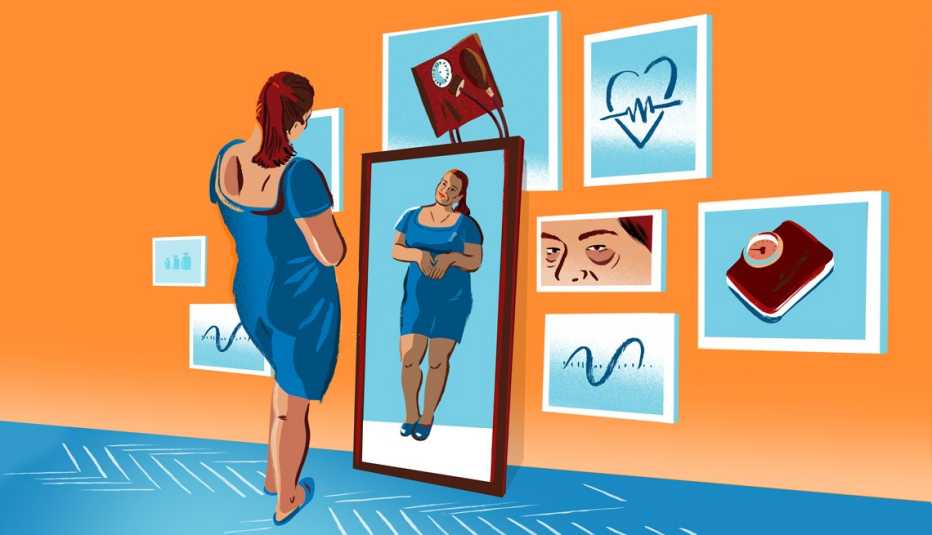AARP Hearing Center


These are the fat years. Your 50s are the time of life when you’re at your heaviest: A full 44.3 percent of Americans ages 40 to 59 are considered obese, a higher rate than among Americans in either younger or older age groups. Rates of “severe obesity” are twice as high among people 40 to 59 as they are among those 60 and over.
What’s going on here?
Our 50s are when a bunch of trends collide. Hormone changes in this decade cause us to accumulate fat, especially in our midsections. At the same time, age-related muscle loss means our bodies don’t burn as many calories or process blood sugar as efficiently. All of that, experts say, leads to an increased risk of obesity and with it a cascade of health complications — high blood pressure and cholesterol, type 2 diabetes, sleep apnea, a decline in physical functioning and more.
How many pounds you weigh isn’t everything; there are plenty of people above the usual weight targets who are fully healthy. But we rely on weight as an indicator of how much body fat we’re carrying. And body fat, including where it exists, is highly influential to our health in many nonobvious ways. Think of body fat as an endocrine organ of sorts, constantly producing and releasing hormones involved in sexual function, blood clotting, blood pressure, insulin sensitivity and many other roles. Being overweight isn’t necessarily a serious health issue, but being obese, and having lots of chemical-producing abdominal fat, definitely is. So: Where is that line? How do we know?
Doctors use the BMI — for “body mass index” — scale as one measure of body fat to determine whether you’re underweight, at a healthy weight, overweight or obese. Your height and weight are plugged into a formula (your weight in pounds times 703, divided by your height in inches, squared; but please, just use an online calculator) to determine your BMI. A healthy weight is set at 18.5 to 24.9, and obesity is set at 30 and above. “These cutoffs are well defined,” says Gitanjali Srivastava, M.D., medical director of Vanderbilt Obesity Medicine at Vanderbilt University Medical Center in Nashville, Tennessee. “If you have obesity, you’re at risk for metabolic and cardiovascular complications.”
BMI is an imperfect measure because it can’t tell you where in your body your fat lives — and that may be what matters most. “Visceral fat is the fat that’s hidden in your abdominal cavity,” says Jean-Pierre Després, a professor in the department of kinesiology at Université Laval in Quebec City, Canada. If you have too much of it, it can indicate that there is too much fat wrapped around your heart and in your liver. That’s far more dangerous than other types of body fat. More visceral fat means more than just a wider waistline; it means a higher risk for heart disease, diabetes and stroke.
5 things to know about weight gain in your 50s
There are several reasons your weight may be snowballing in your 50s, and it’s (mostly) not the fault of bad habits. “Our bodies are different in our 50s from when we were in our 20s and 30s,” Srivastava says.
1. Muscle loss has caught up to you
Starting at age 30, we begin to lose muscle at a rate of 3 to 8 percent per decade. Less muscle means a greater percentage of our bodies is made up of fat. “For reasonably healthy adults, there’s a natural increase in body fat percentage until the 80s,” says Kristen DeCarlo, M.D., a geriatrician who practices in the areas of endocrinology, diabetes and metabolism at UI Health in Chicago.
2. You’re probably still eating like you’re 30
Eating behaviors from your younger years — when you were more active and burning more calories — may not change just because you’re older and wiser. “We’re creatures of habit,” DeCarlo says. “We see that younger adults expend about 300 to 500 more calories per day than older adults. But you may still be eating in the same old way because you’ve gotten used to it over the years.” This growing calorie excess causes weight gain, a disproportionate amount of which — up to 70 percent — is stored fat.



































































More From AARP
Your Weight in Your 60s: What It Means for Your Health
Discover some truths about those extra pounds and six effective weight-loss strategies to start today
Your Weight In Your 70s, 80s, 90s: What It Says About Your Health
Here are some surprising truths about our changing bodies, and what those changes really mean to our longevity
Weight Loss After 50 Challenge
Learn how to lose weight and keep it off, and get delicious recipes at AARP® Staying Sharp®